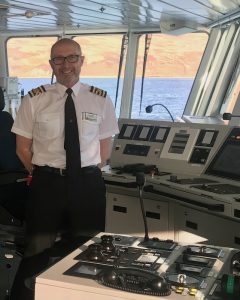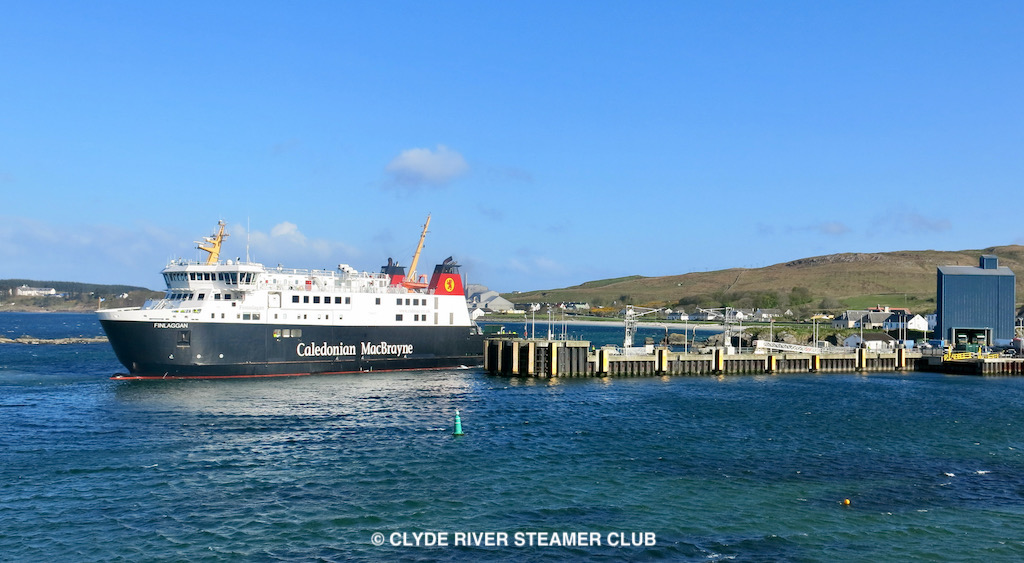
‘Throughout my career there are bits I’ve learned from everybody’: John Gillies (centre) as 2nd Mate of Hebrides in 2001, the ship’s first year in service, with Chief Officer Lewis Mackenzie (left) and Captain Donald Gunn (right). In his early CalMac career John also served on Lord of the Isles and Iona
Captain John Gillies spent his early career on the decks of ocean-going bulk carriers, before going home to join the locally recruited crew of the wee Raasay ferry. It was not until he was 38 that he became an officer on one of the big CalMac ferries. He has never looked back.
This is the second part of an interview by CRSC magazine editor Andrew Clark. To read the first part, ‘Captain John Gillies: how CalMac crews coped with Covid’, click here.
If you get a job you love, you never have to work again. The words leap out of John Gillies’ conversation and seem to sum up his philosophy. He loves being at sea.

Captain Gillies on the bridge of Finlaggan on 25 February 2021. Referring to some of his formative experiences on the Raasay ferry and Lord of the Isles, he says he learned to ‘watch the weather patterns, when the wind is going to shift — I carry that with me’
One of the most approachable and versatile Hebridean masters, John describes his years as a CalMac officer as “a second chance, a new career” — an assessment based on the fact that, between leaving deep-sea in 1983 and joining Lord of the Isles as Second Officer in 1997, he worked on the Raasay ferry, spending every night on the island under the same roof as his young family. During those stay-at-home years, Raasay was ‘turning a corner’, the school roll was expanding and John had ample time for community life and odd jobs. Although owned and financed by CalMac, the ferry at that time was administered locally.
As a pupil at Portree High School in the early 1970s, John had crossed to Skye on a Monday and returned to Raasay on a Friday, usually on MacBraynes’ Loch Arkaig or the local passenger ferry Dignity. A regular car ferry service did not begin until 1974 (by Eigg, initially from the old Raasay pier to Portree, and in 1976 to Sconser). By the time he left school in 1978, he had made up his mind to become a seafarer — against the wishes of his father, a fisherman, who “eventually gave his blessing ‘as long as you don’t work for MacBraynes’,” John, 61, recalls with a wry smile. “He didn’t like the drinking culture. We knew people who worked for the company and had alcohol problems. It was not a lifestyle you would advocate for your kids. He was protecting me.”
By the mid 1990s John was in a rut. CalMac, responding to the introduction of ISM safety regulations, was taking a closer interest in the Raasay ferry, giving John the impetus “to do something different”. The safety checklists he drew up impressed CalMac managers. He already had his 2nd mate’s certificate, and in 1997 he revalidated his radio qualification. “I told them I could do with a change.”
Less than two weeks later he was called up as 3rd mate on Lord of the Isles. “I had no uniform — I was green as grass”. Noting that the most recent entry in John’s discharge book was 1983, Captain Ian Dewar asked ‘where have you been all this time?’.
“It was like starting over again,” says John. “I’d never been to Castlebay or Lochboisdale, and when we went in, it was pitch black and howling. In the morning, when I woke up at Lochboisdale and saw how narrow the entrance was, with the bay tight with reefs, I said ‘no way I’m ever going to be a skipper’.”
Working with experienced masters helped to change his mind. “There were no internet forecasts back then — the master would simply phone the lighthouse keeper at Hyskeir [an exposed island outcrop, now unmanned, southwest of Rum] to see what conditions were like. As a junior officer you got a good grounding [in seamanship and ship handling] before all the modern aids. The likes of Hughie Sinclair, Ian Dewar and Norman Martin would know by the wind in Oban how long it had been blowing and what the swell would be like at Tiree. LOTI had lots of power, but these guys had been used to ships with telegraphs: they had to think ahead and use wind and rope more.”

John with his father Calum on the occasion of Hebrides’ first visit to Uig in 2001. Calum Gillies, now 92, did not want his son to go to sea, but eventually gave his blessing ‘as long as you don’t work for MacBraynes’. John says his father is now ‘very proud of what I have done’
Recalling those early days, John says Lord of the Isles “seemed to drop into huge seas that appeared from nowhere. I would think of everyone in Raasay tucked up safely in bed and say to myself ‘This is crazy’. But she had a good crew and the ‘craic’ was great.”
After helping to bring out Clansman in 1998 and Hebrides in 2001, John spent nine months at college in Glasgow studying for his chief officer’s certificate. He was supposed to return to Hebrides but made a request to ‘go relief’ in order to “see how other crews work. You can get blind: ‘this is the only way to do it’. Throughout my career there are bits I’ve learned from everybody, including galley boys and engineers. I’ve relieved on every ship in the fleet except Lochnevis, Caledonian Isles, Argyle and Bute.”
He sat for his master’s ticket in 2005 and, before getting his own boat in May 2008 (Hebrides for a fortnight), spent two years as mate — “the rank everyone wants to pass through quickly. It’s the hardest rank, because a lot of responsibility falls on your shoulders — deck crewing, maintenance, loading, safety officer, medical officer, security officer, plus he has a watch when no paperwork can be done, unlike other heads of department.”
After that short spell on Hebrides, John spent two and a half years as master of Isle of Arran, the start of a love affair with the Islay run. “You can’t beat the scenery, and you get the feeling that the ferry is part of the island, unlike Lewis and Harris, where you feel more anonymous. When I was promoted, I felt trepidation because Islay was the route I knew least, but when I got there I found nice little ships that fitted the piers well. With the open bridge wings you get a better feeling for the winds. You can try different things in a way you might not on other routes. The hours are long, but it’s a happy route.”
John then ‘stood by’ Finlaggan during the final stages of her build at Gdansk in 2011, and similarly Loch Seaforth at Flensburg in 2014, by which time his knowledge of the fleet was as good as anyone’s. Summarising the quirks of the various vessels he has commanded, he talks of Lord of the Isles’ “corkscrew motion” when plunging into a trough, Isle of Lewis’s “banging” tendencies in a heavy sea, the occasional operational problems of Clansman’s lift due to its for’ard location, and the restrictions imposed by Hebrides’ lower mezzanine deck, which can create problems for unwary mates when loading four-decker sheep floats.
As for Isle of Arran and Hebridean Isles, “everyone says they are under-powered, but Donnie Finlayson used to say ‘you work with the tools you’re given’. Although they are lighter and more lively at sea than the newer vessels, in enclosed spaces they have lower windage. Vessels like Clansman and Loch Seaforth have the advantage of greater power and manoeuvrability, but they are also heavier. When berthing, the momentum is far greater at the same speed than it would be with one of the smaller vessels, so the potential for damage [through contact with the pier] is much greater.”
Turning to Loch Seaforth, John says that, despite having the same engine power as Finlaggan, the Stornoway ferry’s hydrodynamic hull gives her a faster service speed (19.2 knots against 16.5), and “they’d have got an even more efficient ship if they had made her a bit longer. But the economics of the two piers [at Stornoway and Ullapool] meant this was the optimum size. Her duck tail gives her a good wave form — there’s very little wash — but she’d be much better with a Becker rudder”, for the lack of which her stern thruster, unique in the fleet, is insufficient compensation.
Recalling the occasion on 8 August 2018 when the ‘Seaforth’ lost power in open sea en route to Stornoway, John says “it all happened very slowly. An hour out from Ullapool, just when we were coming into the Minch clear of Priest Island, the engine-room told us there was air in the cooling system and asked us to slow down so that they could have a proper look. It started to affect other pieces of machinery. Initially we thought of turning back, but the weather was calm — it was a good day for the crossing and we reckoned that, if the worst happens, we could get to Stornoway on one engine. There was a lot happening, with the engine-room staff trying to source the problem. We lost air conditioning and toilets. When they started to lose a generator, they assumed that was the problem. Then they started looking at the port engine. The last thing to fail was the starboard engine.

John was in command of Loch Seaforth when she undertook an extensive series of trials early in 2015 before entering service on the Stornoway-Ullapool service. She is pictured manoeuvring in Churchton Bay, Raasay, from a viewpoint close to John’s home
“We were halfway across when the engineers stopped her, before any damage was done. We had discussed all the issues — it wasn’t as if she just conked out. Kenny More, the chief engineer, was very cool and calm. ‘If we have to stop her, is it ok?’. The relationship with the chief is very important. I kept making regular announcements. By this stage lifeboats were mobilised, the coastguard tug was on its way. We knew we weren’t in any danger, but we were in a bad spot for communications.
“There were more than 300 passengers on board. Eventually I thought it was better if they actually saw me, so I went down. I was surprised how accepting everybody was. I remembered Hughie Sinclair telling me that ‘it doesn’t matter how much you’re panicking, just don’t show it’. You go into professional mode — that’s something that comes with experience and knowledge. Kenny kept me updated throughout — the engineers were hopeful they would find something, but eventually there was just too much air in the system.”
John says it was teamwork by the crew that saved the day. The engineers managed to fire up one of Loch Seaforth’s three main generators to get the onboard services going, and then they succeeded in getting another generator and the port engine to run, enough to get her to Stornoway at reduced speed. The incident attracted a lot of publicity: the ‘Seaforth’ is, after all, the largest, most sophisticated and most expensive ship to have been commissioned for Hebridean service. Since that incident, she has been a model of reliability.
John says he has not been consulted about the specification of the proposed new Islay ferry, and has been getting “mixed messages” on plans to upgrade the piers — a necessary step if Port Askaig and Port Ellen are to accommodate a ship of greater length. “Kennacraig will have to be lengthened, but the problem with all such plans is that they are rarely future-proof. I don’t blame the designers. It’s the politicians who are at fault — they’re not interested in what happens when the next new ship comes along. It’s all short-term thinking: ‘if we can get away with that now, we’ll make do’.”
© CRSC. No reproduction of text or pictures without written permission: info@crsc.org.uk
See also — Captain John Gillies: how CalMac crews coped with Covid
●
Below you will find a 21-second video taken by Captain Gillies from the port bridge wing of Loch Seaforth, showing the brief appearance of the ship’s stabiliser fin in a lively beam sea. His voice can be heard towards the end of the clip. After clicking the arrow, you may have to allow a moment or two for the sequence to start:
●

Lord of the Isles at Uig on 20 February 2021. This is the vessel on which John Gillies ‘cut his teeth’ as a junior CalMac officer in the late 1990s. He recalls one stormy voyage between Lochboisdale and Castlebay when ‘the boat just seemed to drop into these huge seas that appear from nowhere. We call it the Eriskay holes, and Lord of the Isles is very prone to it because she is so short. She’s got a motion that corkscrews when she goes down — I’d never seen anything like it. I never liked her as a sea boat, but I love the ship’

In 2008 John Gillies became master of Isle of Arran, staying with her for the next two and a half years — an assignment he looks back on with great affection. This crew photo dates from c2009: (standing, left to right) Kenny More chief engineer (now doing reliefs), JG master, Farqhuar Morrison chief steward (retired), A J MacMillan steward (now on Hebridean Isles), John Campbell steward (hidden, now on Loch Seaforth), Vineet Mulay 2nd officer (left company), Sean MacVicar steward (left company), Keith Warner engine room watch rating (still on Isle of Arran), Alastair Kernahan chief officer (retired), Mick Mcgovern chief cook (now on Hebrides), Karin Boyd stewardess (left company), Eddie Reid quartermaster (now on Finlaggan), Robert Watson deck crew (retired), Victor Burns cadet (now 3rd officer on Loch Seaforth); (seated) Pat Gallacher 2nd steward (retired), P J MacAllister bosun (still on Isle of Arran), Bobby Bruce carpenter (retired/deceased), Iain McGillivray deck crew (now 2nd officer reliefs), Duncan McSporran deckhand/carpenter (retired), Scott Paton engine room watch rating (still on Isle of Arran)

Deck cadet John Gillies, aged 18 — photo from his first discharge book, issued when he joined Nordic Sky near Quebec in 1978

John (right) with brother Alastair on the deck of MV Raasay c1985. Until the mid 1990s the Raasay car ferry was CalMac-owned but locally crewed and operated

The pier at Port Ellen, viewed from the protective finger of land known as the Ard. Manoeuvring space is constricted by a green marker buoy in the centre foreground (in line with Finlaggan’s port-side funnel) and an outcrop of rocks on the left, close to the pier. Will the existing structure be long enough for the planned new Islay ferry? Is there sufficient ‘swing room’ for a longer ferry in the port’s confined space? A £400,000 upgrade to the pier was completed only four-and-a-half years ago: it was much less ambitious than CalMac masters had called for. Captain Gillies says flawed port infrastructure tends to reflect politicians’ shortsightedness, rather than shortcomings in the planning process
●
How about joining CRSC? You can do so for just £10 by clicking here — and you’ll receive all the benefits, including our annual Review of west coast ship movements, a 56-page colour magazine, discounts on photo offers and access to photo-rich ‘members only’ posts.
Published on 28 February 2021












